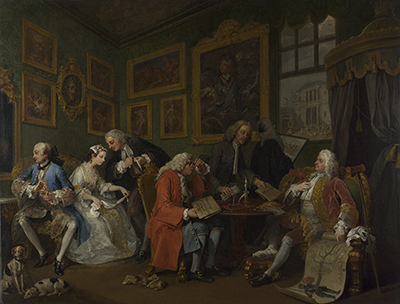The Marriage Settlement involves one of the six paintings in a series which were done by William Hogarth starting from the year 1743 and the year 1745. In the series, which Hogarth referred to as Marriage A-la-Mode, he painted six satirical pictures which were warning against the aristocratic-class custom of carrying out contractual marriages.
The narrative advances through the pictures to incorporate scenes of sadness, illness, debauchery, adultery, giving birth to unhealthy baby, climaxing in the killing and the execution of the husband as well as the self-murder of the wife. At the time of painting The Marriage Settlement, William Hogarth was by that time a highly famous painter for his portrayal of the unrespectable underbelly of London. However, it was his series of paintings the Marriage A-la-Mode as well as his depictions of the stylish elite which reinforced Hogarth's popularity as an exceptional painter and an eager social observer.
The painting depicts a marriage negotiation between the rich and the poor parties. The bride is from a rich family as her father is a merchant while the groom is bankrupt. The room is made up of six individuals, all of whom are male except for the bride. Three of them, are sited on one table while the bride, the groom and the lawyer occupy the left side of the room. Even though they are in the process of marriage settlement and decision, the bride and groom are not happy at all. They seem to be ignoring each other as they embark on their activities. The groom appears to be looking at himself in the mirror, which depicts that he is not even interested in the marriage negotiations.
On the other hand, the bride appears sad, and she seems to be comforted by the lawyer. On the right side, gold notes are scattered on the table. One of the men at the table seems to be pointing at a structure in the middle of the table while the other two are holding pieces of paper in their hands. Just next to the bride and groom are two chained dogs that are kept together for the sake of breeding. These dogs do not support the chaining as it deprives them the freedom to engage in their activities without being monitored or being forced to do anything that they do not desire. This is in line with the situation that the current couples are going through as they do not seem to love each other. Markedly, they are forced by both circumstances and their families to engage in the loveless companionship. The theme of the painting is marriage while the mood is sad and unhappy because the bride and groom are unhappy contrary to the expectation in such situations. The material used for the painting is paper, while the technique applied is engraving. The painting was developed in greater London.




